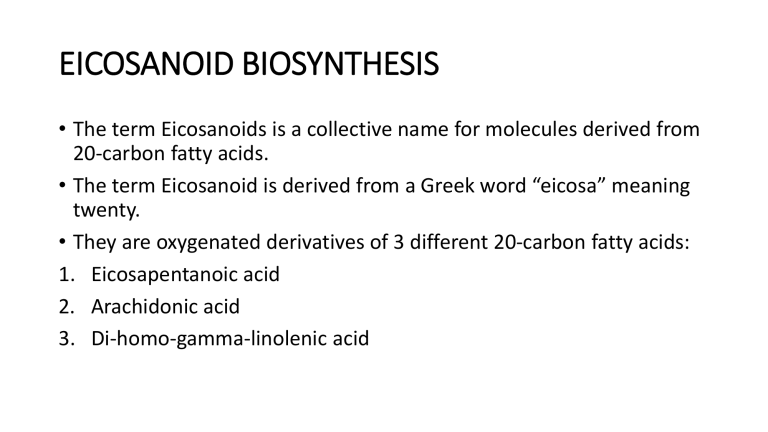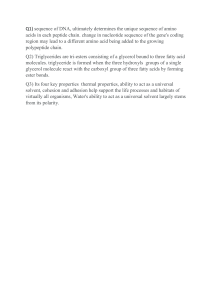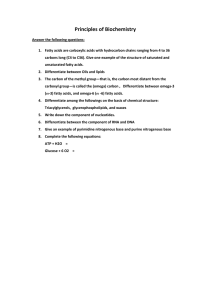
EICOSANOID BIOSYNTHESIS • The term Eicosanoids is a collective name for molecules derived from 20-carbon fatty acids. • The term Eicosanoid is derived from a Greek word “eicosa” meaning twenty. • They are oxygenated derivatives of 3 different 20-carbon fatty acids: 1. Eicosapentanoic acid 2. Arachidonic acid 3. Di-homo-gamma-linolenic acid Introduction Cont.. • Eicosapentanoic acid: An omega-3 fatty acid with 5 double bonds • Arachidonic acid: An omega-6 fatty acid with 4 double bonds • Dihomo-gamma-linoleic acid: An omega-6 with 3 double bonds. There are three groups of eicosanoids that are synthesized from C20 eicosanoic acids derived from the essential fatty acids linoleic acid (omega 6) and linolenic acid (omega-3) Classification of Eicosanoids Classified into two main groups • Prostanoids • Leukotrienes • Lipoxins • Prostanoids are sub classified into three groups: 1. Prostaglandins (PGs) 2. Prostacyclins (PGIs) 3. Thromboxanes (TXs) • Prostaglandins(PG), thromboxane (TX), leukotrienes(LT), and lipoxins (LX) physiologically, are considered to act as local hormones functioning through G-protein-linked receptors to elicit their biochemical effects. BIOSYNTHESIS • Two families of enzymes catalyze fatty acid oxygenation to produce the eicosanoids: • Cyclooxygenase (suicide Enzyme), or COX, generates the prostainoids. • Lipoxygenase, or LOX, in several forms • 5-Lipoxygenase generates the leukotrienes and via transcellular biosynthesis is also involved in lipoxin generation. • Eicosanoids are not stored within cells, but are synthesized as required. • Derived from fatty acids that make up cell • Arachidonate, is usually derived from the 2 position of phospholipids in the plasma membrane by the action of phospholipase A2, but also from the diet SITES OF HYDROLYTIC ACTIVITY OF PHOSPHOLIPASE FORMATION OF ARACHIDONIC ACID FROM LINOLEIC ACID THE CYCLOOXYGENASE PATHWAY THE LIPOXYGENASE PATHWAY




